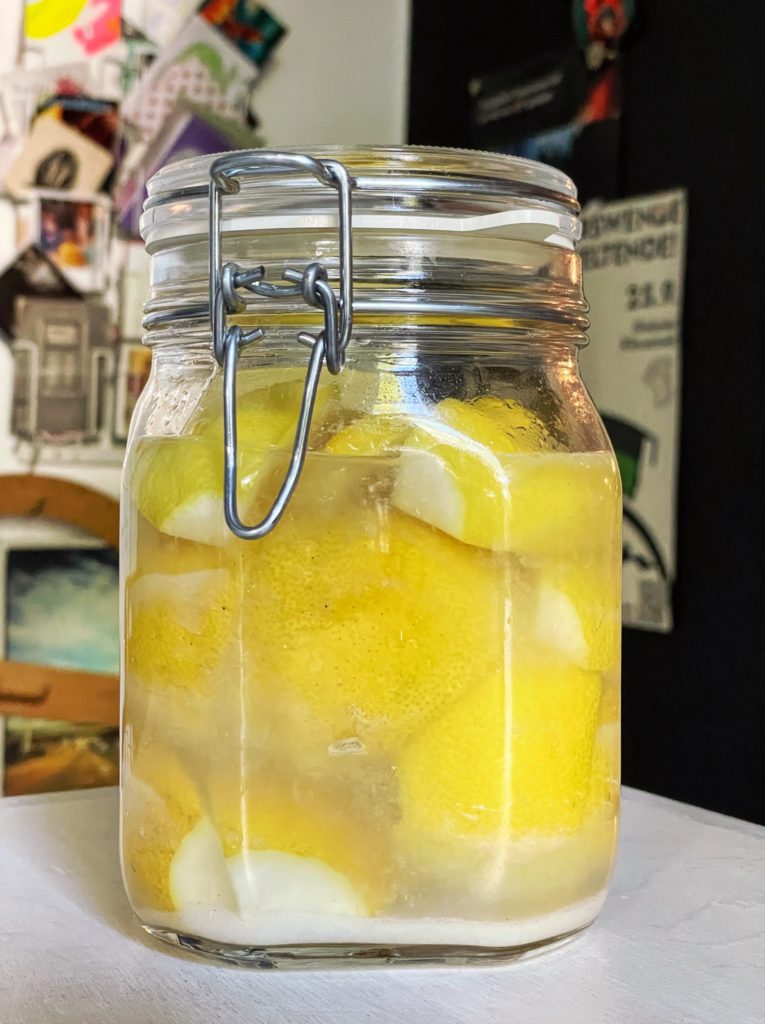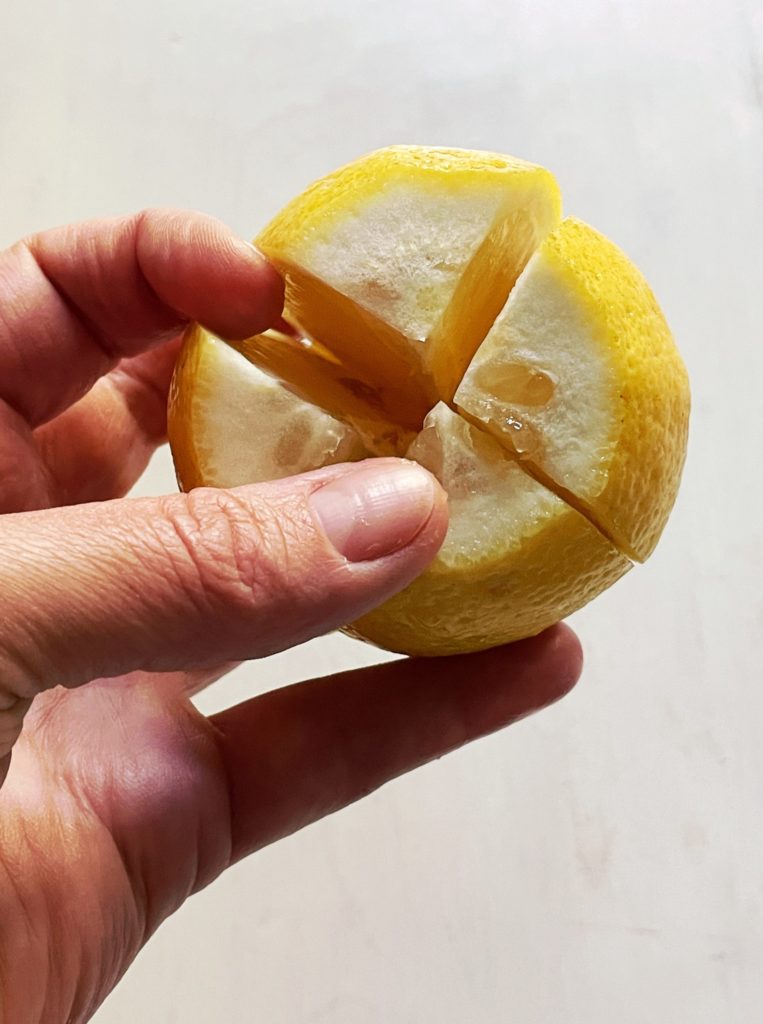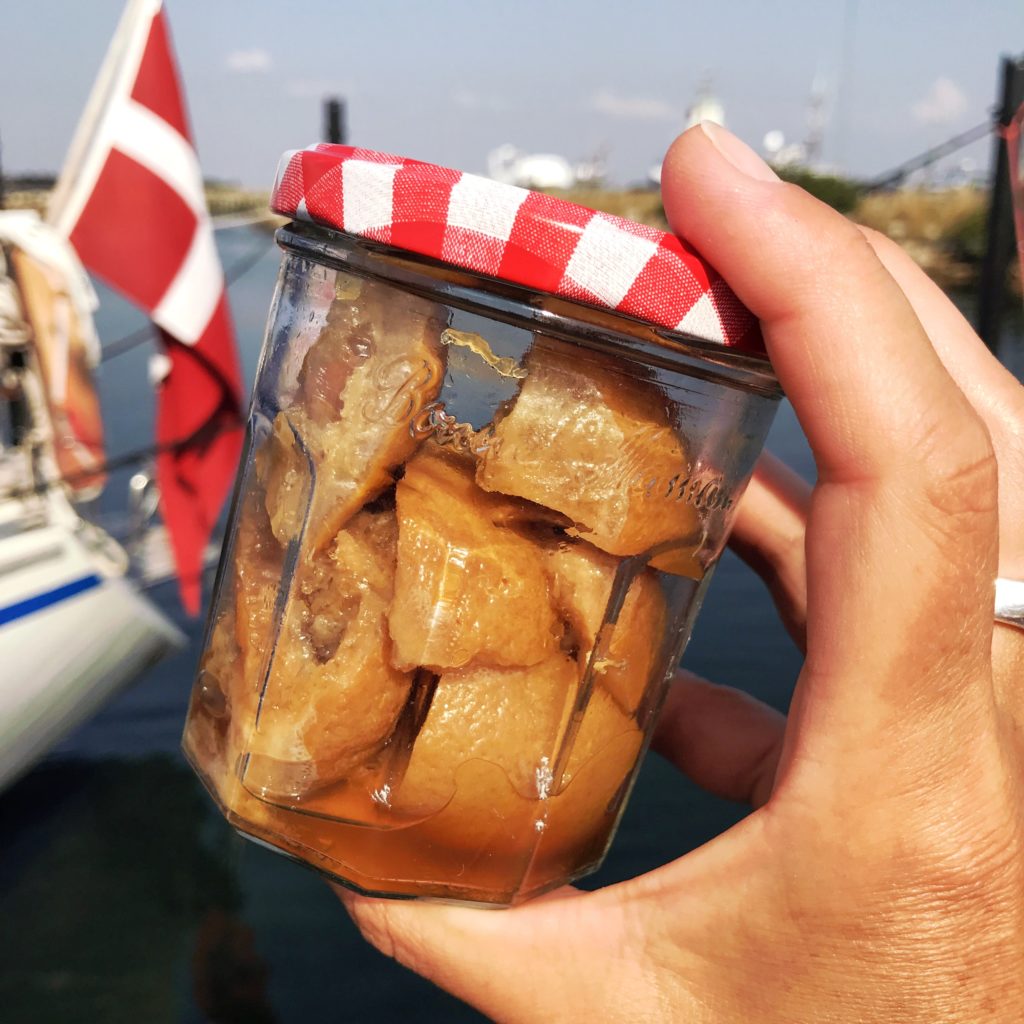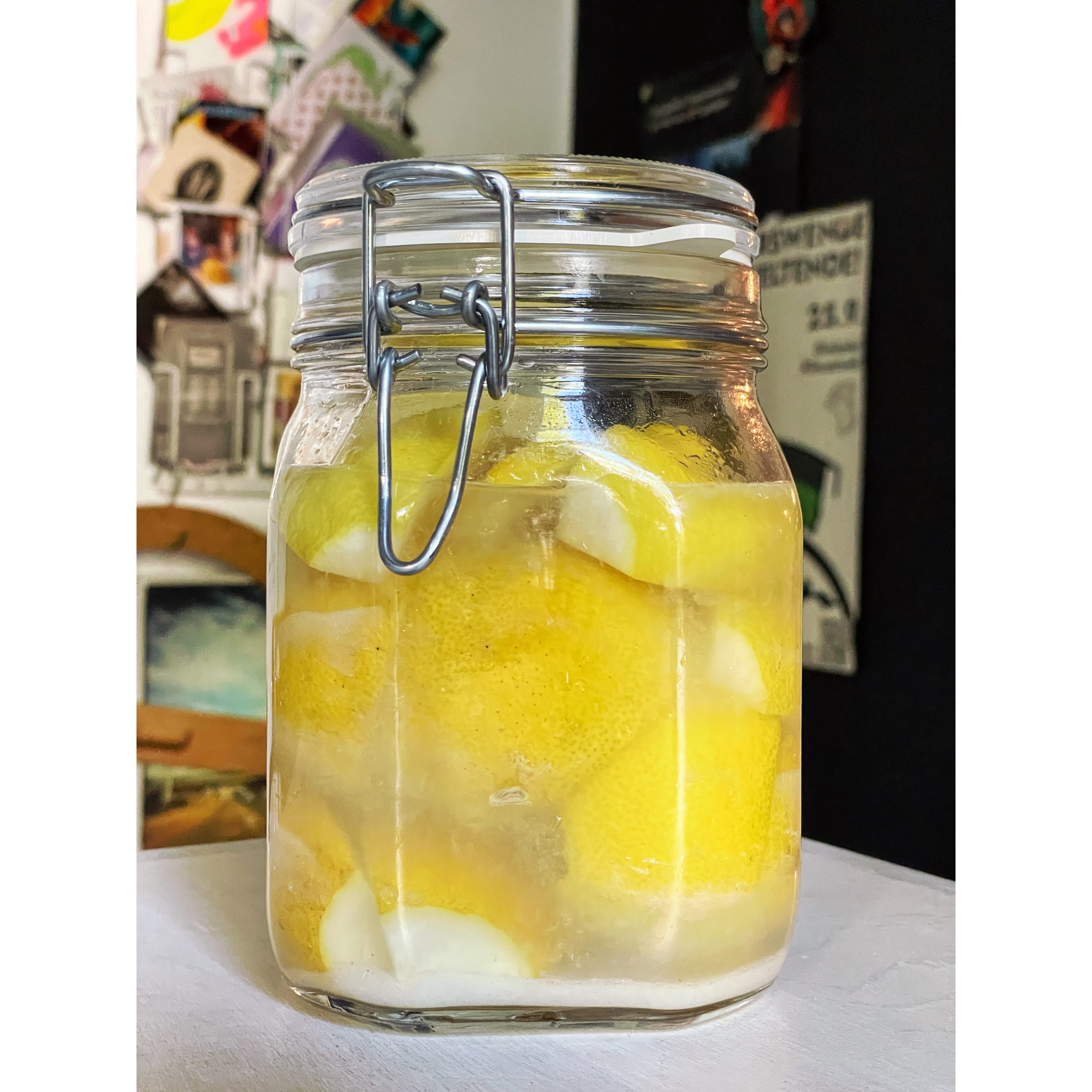This ferment is a true classic. In fact, fermented lemons are probably the most commonly fermented fruit in the world, I would like to think. And with good reason: The preservation process changes the taste and consistency in the most delicious way. Sharp acidity becomes mild freshness, bitterness becomes subtly tart, and the zest melts delicately on the tongue when eaten. Just two ingredients and a few minutes of time is all you need to make your own fermented lemons.
Jump to recipeWith salt lemons, by the way, the focus is not on the flesh, but on the zest and the brine, which becomes gelatinous after some time. This is due to the high pectin content, so it behaves like jam. Because the zest is also consumed, it is particularly important with this ferment that you use untreated lemons in organic quality. Which salt to use you can decide yourself. I like coarse salt because it makes filling the lemons easier. Fine salt would dissolve more quickly, which can also be good. Feel free to decide according to your own preference.
Fermented lemons are characteristic of Moroccan cuisine
The lemons preserved in salt and their own brine are a specialty and a fundamental ingredient of Moroccan cuisine, which is why they are often called Moroccan lemons, as well as salt lemons. In Morocco, only the ingredients salt and lemons are used. Traditionally, spices such as cinnamon, bay leaves or other herbs are not used. These variations were created when this ferment began to spread and found its way into other cuisines.



Cooking with fermented lemons
In North African cuisine, fermented lemons are used as a seasoning for stews and tahini. To flavor butter, as a tangy ingredient in cocktails or a surprising touch to pasta or risotto, even outside of Moroccan cuisine there are many possibilities for use, because you can use both the fruit and the brine. Wonderful dressings, creamy sauces or soups get a unique taste with this magic ingredient.
Before eating, you can rinse the lemons. The pulp is traditionally removed and the peel cut into fine strips or cubes. I don't like to throw anything away and like to eat the pulp along with it. After a few months, anyway, the whole ferment is so jellified that you can't tell a disturbing difference between pulp and brine.



Das Fruchtfleisch mit Öl und Gewürzen püriert, ergibt eine wunderbare Grillmarinade für Fisch, Huhn und Schweinefleisch.
Mit Sahne/Joghurt/ Schmand, Öl und Honig gemixt ein schön frisches Salatdressing.
Liebe Irmgard,
das sind tolle Tips für die Leserschaft, merci.
Es grüßt
Katsu
de rien
Ich hab die Zitronenschalen von Biozitronen immer dünn abgeschnitten und gehackt und mit Honig/Zucker eingelegt.
Und dann fand ich es schade das man den dicken weissen Teil nicht verwertet weil der muss doch auch irgendwo gesund sein für irgendwas. Und dann hab ich einfach mal 4 ausgepresste Zitronen komplett klein geschnippelt und mit Salz in ein Glas getan.
Lecker, gerade soviel Saft ins Glas das alles bedeckt war was nicht viel war und hab dann erst 2 Jahre später erfahren das Salzzitronen tatsächlich etwas sind das verkauft wird.
Ich habe diesen fermentierte Salzzitrone auf der Reise kennengelernt. Marokkanische Rezept. Das fermentierte Fruchtfleisch wurde hauch dünn geraspelt und in den heißen Reis gemischt. Das war beinah magisch, wie schmackhaft alle Gerichte dadurch verwandelten. Der Duft!
Hallo, kann man das auch mit Limetten machen?
LG
Japp, kannst du machen. Dann füllst du mit Lake statt mit Limettensaft auf. Schmeckt super mit Mineralwasser als sommerliches Erfrischungsgetränk!
Weshalb nicht mit Limettensaft?
Nur mit Lake oder auch Salz in die aufgeschnittenen Limetten? Wie berechne ich dann das Salz?
Wird das mit Lake dann auch gelig?
Sorry, ich bin jetzt verunsichert. Über Salzlimetten finde ich nichts.
Du kannst auch die Limetten erstmal nur salzen und abwarten, wieviel Saft sie ziehen. Falls es nicht reicht, mit 10%iger Lake auffüllen. Ich schneide sie nicht kreuzweise ein, sondern in breite Streifen.
Gutes Gelingen!
Ich habe die Limetten jetzt in ca. 1,5 cm breite Spalten geschnitten, ich nehme an, dass Streifen so gemeint waren. Dann alles mit 10% Salz vermengt, leicht ins Glas gedrückt, Spalten sind es noch. Jetzt, nach 4 Stunden, ist die Flüssigkeitshöhe mit der Fruchthöhe gleich. Ich habe mit Glasdeckel beschwert.
Ich werde erstmal täglich mehrfach schwenken. Die Schale ist recht dünn, wahrscheinlich ist der Ansatz mit Zitronen nicht vergleichbar. Wenn es nach 14 Tagen nicht schimmelt, werde ich es noch mit Zitronen versuchen.
Hej Frieda,
das klingt gut!
Viel Erfolg,
Katsu
Hallo Kaksu,
die Limetten sind schon mal lecker geworden. Danach habe ich es noch mit Zitronen versucht, dass ah erst ganz gut aus, so wie die Limetten auch. Nach 6 Wochen haben sich 3 Pünktchen auf den obersten Zitronen entwickelt. Ich dachte, es sind Salzkristalle, es veränderte sich nicht weiter. Nach 3 Monaten öffnete ich das Glas mit den Limetten und als dieses Glas halb leer war wollte ich die Zitronen versuchen. Die Pünktchen haben sich bis dahin nicht verändert, ich schaute sie mir aber vor dem Probieren doch mal mit der Lupe an. 🙁 Die Pünktchen hatten kleine Stacheln … ähm, wohl eher Haare, das war wohl Schimmel. Ich habe sie schnell raus gebracht und entsorgt. Schade drum.
Ich möchte Zitronen jetzt trotzdem noch einmal versuchen, nur nicht wieder ein großes Glas voll. Ich frage mich nur, weshalb man die Zitronen nur anschneidet und Ganz ins Glas tut, fördert das nicht eher den Verderb, weil innen nicht genug Salz ist? Ich könnte doch auch Spalten schneiden?
Danke schon mal und LG Frieda
Hej Frieda,
dann stand die Lake wohl nicht über den Zitronen? Das muss schon sein, lies mal Punkt 5 im Rezept, bitte. Klar kannst du auch Spalten schneiden oder Scheiben. Ich habe die traditionelle Variante übernommen, das gefällt mir am besten. Und innen drin ist ja viel Salz, das tust du ja in jede Zitrone rein.
Gutes Gelingen!
Katsu
Hallo Katsu, in den ersten 14 Tagen war alles bedeckt, dann wurde der Saft immer weniger, ich dachte, es ist richtig so, wenn es geliert. Bei den Limetten war es auch so. Ich hätte wohl dann Saft nachschütten müssen.
Diesmal ist so viel Saft ausgetreten, dass es er fast überläuft. Muss ich jetzt etwas davon raus nehmen?
LG
Hej Frieda,
wenn 14 Tage alles bedeckt war und das Glas gut verschlossen, kann eigentlich nichts schimmeln. Vielleicht war der Gummiring schon porös? Und nein, bitte nicht öffnen. Wisch alles zeitnah ab, was überläuft, das hört irgendwann auf.
Toi toi toi für dieses Glas!
Katsu
Liebe Katsu,
bei mir ist eine weiße Schicht an der Oberfläche entstanden. Ich tippe ganz stark auf Kahmhefe, denn ich habe keine Gewichte verwendet und wohl zu wenig nach unten gedrückt. Von dem, was ich bisher bei dir gelesen habe, ist Kahmhefe aber nicht schädlich. Reicht es also, wenn ich die weiße Schicht so gut es geht entferne und kann dann die Zitronen ganz normal verzehren? Oder wäre es notwendig, nach dem Entfernen der weißen Schicht, erst noch Salzlake aufzugießen und nochmals fermentieren zu lassen bevor ich dann mit dem Verzehr beginne?
Herzliche Grüße und danke im Voraus!
Luisa
Hej Luisa,
das klingt plausibel. Ohne es zu sehen, kann ich dir natürlich nicht wirklich raten, vergleiche bitte nochmal das Aussehen. Kahmhefe riecht ausserdem leicht muffig.
Sollte es tatsächlich Kahmhefe sein, kannst du sie abnehmen. Versuche, die Zitronen danach gut unter die Lake zu drücken. Verzehren kannst du sie trotzdem schon, spül sie vorher ein bisschen ab.
Gutes Gelingen!
Katsu
Liebe Katsu,
mit Deinen Rezepten habe ich bisher nur allerbeste Erfahrungen gemacht, jetzt brauche ich wohl
mal Nachhilfeunterricht.
Am 19.Dezember habe ich Salzzitronen entsprechend Deinen Anleitungen angesetzt. Gestern
habe ich das Glas für eine erste Kostprobe geöffnet. Die ist gallebitter! Das ist mehr als die erwar-
tete dezente Bitternote von Biozitronen.
Wie empfohlen, setze ich die Fermentation mindestens bis zum 19.April fort. Frage: Ist es ange-
bracht, mit frischem Zitronensaft aufzufüllen?
Hej Ilse,
etwas bitter sollen die Zitronen sein, aber gallenbitter klingt nicht gut. Hatten die Früchte sehr viel von dem weissen Teil zwischen Schale und Fruchtfleisch? Das könnte eine Erklärung sein. Ich empfehle dir, dem Ferment noch mehr Zeit zu geben, gerne auch deutlich mehr. Der Geschmack wird sich noch ändern und weniger bitter werden.
Ich drücke die Daumen!
Katsu
Hallo,
wenn ich 4 Zitronen in ein Glas packe , brauche ich mindestens Saft von vier weitere um aufzufüllen oder kann ich auch mit Salzlake auffüllen ?
Bei einem weiterem Versuch habe ich , wie beschrieben, mit einem Stein beschwert. Dann sind trotzdem Zitronenstückchen ( Fruchtfleisch ) aufgestiegen, die nun leider vereinzelt schimmeln.
Was kann ich tun, damit es besser gelingt ?
Hej Dörg,
hast du das Rezept genau gelesen? Dort steht genau drin, wie du es machen musst, damit es gelingt. Und mit einem Stein würde ich kein Ferment beschweren.
Viel Erfolg beim nächsten Versuch!
Katsu
Hallo,
leider schimmeln bei mir die Fruchtfleischstückchen, die trotz Gewicht im Glas, unvermeidbar aufsteigen.
Ich habe die Zitronen wie im Rezept vorgeschlagen zubereitet, allerdings mit Salzlake aufgefüllt, da der Saft von vier Zitronen nicht ausreichend war.
Vielleicht kannst du mir weiterhelfen ?
Hej Dörg,
lies das Rezept nochmal genau, du brauchst nicht aufzufüllen.
Gutes Gelingen!
Katsu
Liebe Katsu,
die Salzzitronen (bei mir in Scheiben) sind ein Ereignis! Ich möchte gleich neue zum Verschenken ansetzen.
Meine Fragen:
– Wenn man nur die Schale verwendet, sollte man vielleicht nur Schalen fermentieren?
– Aber wahrscheinlich hast Du prima Ideen fürs Verwenden der Innereien parat.
Der Gedanke, eine dicke Scheibe aus dem Glas zu nehmen, dann das Äußere vom
Inneren zu trennen, um Letzteres ins Glas zurück zu befördern, gefällt mir nämlich
gar nicht.
Hej Ilse,
lies mal den allerletzen Absatz dieses Artikels:
Die Schale kann absolut mit verzehrt werden.
Guten Appetit,
Katsu